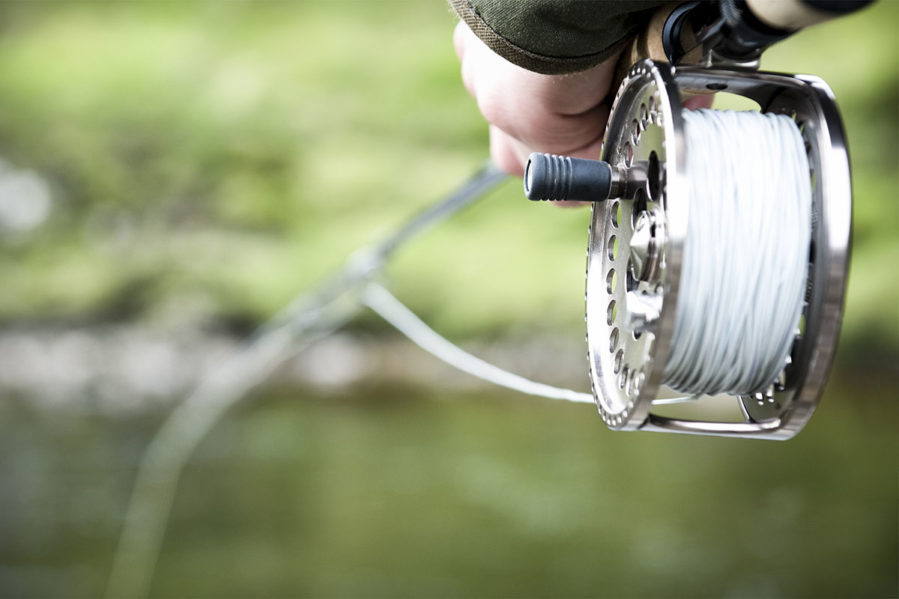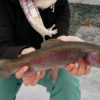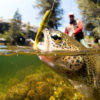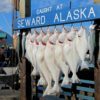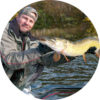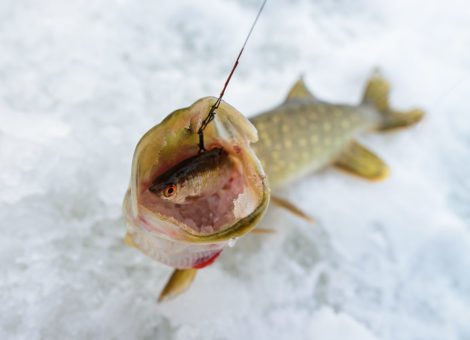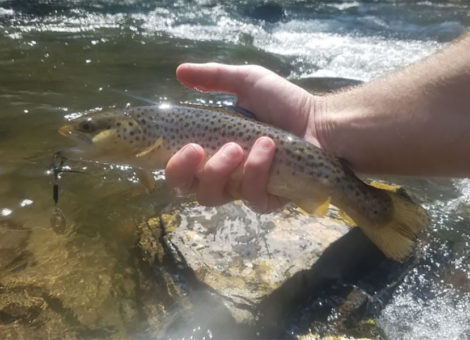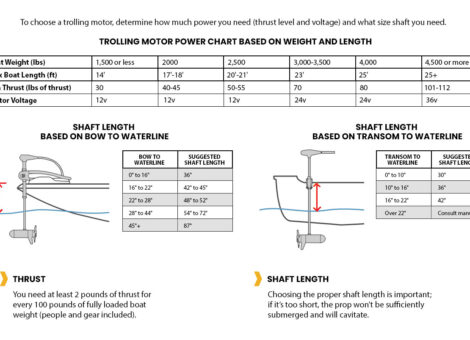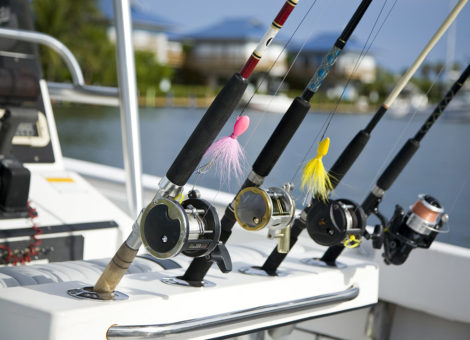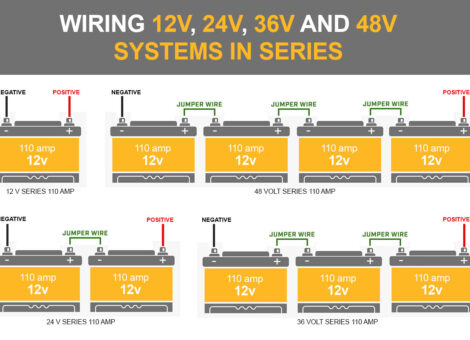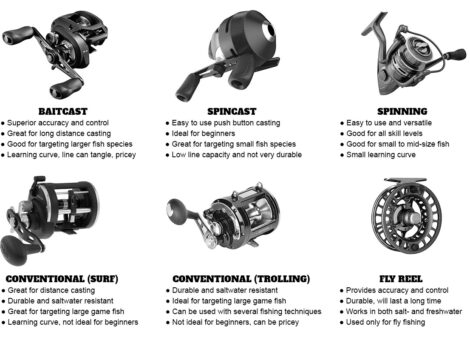Aggressive strikers, fun fighters, and delicious table fare it’s no wonder the country has trout fishing fever. There are hundreds of possible line choices are for trout fishing, so it can be overwhelming to pick the fishing line that meets the requirements of your chosen fishery and trout species. Start by asking the following question: Are you going to be fishing using conventional tackle or fly fishing?
Suppose you plan on using conventional baitcasting or spinning tackle for Trout. In that case, your line choices are relatively simple: either monofilament, braid, or fluorocarbon as a mainline or a mixture of two of the three. If you decide to fly fish for Trout, you have three options as a mainline: Sinking line, Floating line, or a hybrid between the two called sinking tip line.
What is the perfect line setup for Trout using Conventional Tackle? TLDR
- Your choice of 2000 to 3000-size reel
- Your favorite 6-7 ft long light-medium action fishing rod
- 12 lb braided mainline
- A 6 ft long 8 lb fluorocarbon leader
- Braid to fluorocarbon knot: Alberto Knot
Identifying the Best Line for Conventional Tackle
Between all of these line types, the question: “What is the best line to catch trout?” is often a game of mix and match and trial and error. With thousands of hours on the water, I can assuredly tell you that for trout fishing, line size, type, and even color matter, but why? Well, it all has to do with Trout’s extraordinary visual acuity.
Trout have incredible colored monocular and binocular vision for finding prey and avoiding predators. To get an idea of how good their sight is, Trout can target prey, sometimes smaller than a mosquito, several feet away from themselves in turbulent water.
This eyesight evolved for Trout because often the only source of protein for these fish in high alpine areas are these tiny insects hatching from the water. So there is a reason why when you throw fluorocarbon, and your buddy comes throwing monofilament, you outfished him 3:1 that day. But why is that? Why is fluorocarbon so special?
The answer to “Why is fluorocarbon so special?” is a bit more complicated, and it all has to do with the refraction index. This index translates to how much light is passed through the line vs. absorbed and reflected off it. So the lower the index, the more light will pass through an object and not reflect off it. Monofilaments have a higher overall refraction index, typically 1.5-1.6, than fluorocarbons, around 1.3 to 1.35.
To put that into perspective, pure water has a refractive index of 1.333, while materials like plastic or plate glass have a refractive index between 1.5 and 1.6. For example, if we examine a plastic water bottle underwater, we can see the bottle’s plastic in the water but not the water or air inside the bottle. If we take a piece of high-quality fluorocarbon into the water, it almost completely disappears. That’s because fluorocarbon is closer to the refractive index of water than monofilament.
Because braided lines are weaved together using many individual fiber strands, they have a significantly higher refractive index than either monofilament or fluorocarbon. That is why the braid is rarely used as a mainline connecting to the terminal tackle at the end of the rod. If you are dealing with line-shy fish, your lure or bait might as well be hanging off a piece of anchor rope.
Monofilament Line
| Pros | Cons |
|---|---|
|
|
Monofilament lines are essentially pieces of extruded nylon filament. Their chemical makeup has oxygen double-bonds, nitrogen, and carbons in their chain, making this line highly reflective of incoming light. This chemical composition makes monofilament lines highly elastic and can stretch significantly before reaching their breaking strength.
Monofilament lines are great for trout fishing if you are fishing in cloudy or murky water where the line won’t be as noticeable for line-shy Rainbow or Cutthroat Trout. Contrary to popular belief, monofilament lines do not float but have slightly negative buoyancy. Because of this buoyancy, optimal baits are those you want to keep at or near the surface when fishing in fast or shallow water.
Because of their elasticity and strength, monofilament lines are fantastic options for trolling tactics, bladed baits, and crankbaits. These lure types rely on reaction strikes, where the fish often doesn’t have enough time to decide if a line is attached. Jerk baits, spinners, and top-water lures are perfect for monofilaments when fishing for Trout in these conditions.
Fluorocarbon
| Pros | Cons |
|---|---|
|
|
Monofilament lines are suitable for trout fishing, but only when the conditions merit their usage, i.e., murky, cloudy water and baits that need to be just under the surface. Trout in clear water can be especially line-shy if there is a lot of pressure on them. A fluorocarbon leader is a requirement in these situations.
As the name suggests, fluorocarbon comprises long chains of fluorine and carbon single bonds. This smaller structure also gives fluorocarbon lines significantly higher density than monofilament lines, allowing the line to sink faster. This structure also has a considerably lower refractive index value, making it almost invisible in the water column. These two factors combined let lures and bait sink deeper and have a more natural presentation for hungry Trout.
Fluorocarbon’s higher density also translates to higher abrasion resistance, so it’s perfect for lines constantly bumping the bottom or into structures where the integrity of monofilaments might be compromised. This higher density also has a caveat; if the line is bent or kinked, it needs to be replaced because the structure’s integrity has been compromised.
Braided line
| Pros | Cons |
|---|---|
|
|
Braided lines have the highest refractive index and typically only sink once fully saturated. However, due to their low volume, even the lightest weight generally is enough to break the surface tension of the water letting your baits and lures sink with ease.
Braided lines are usually comprised of 4-8 strands of fibrous material woven together like a rope and dyed to various colors depending on the conditions being fished. Because of their high visibility in the water, braided lines are seldom connected to the terminal tackle. Usually, a monofilament or braided line leader is used to connect the line to the terminal tackle using a variety of knots or swivels.
This casting distance can be an invaluable tool for trout fishing in open water or rivers when casting across large shoals or flats. Because braided lines have extremely low diameters, they usually translate to much farther casting capabilities than their monofilament or fluorocarbon counterparts. Their woven structure also has almost zero elasticity, which translates to incredible sensitivity to the terminal tackle by the angler. Ideally, a braided line with a long fluorocarbon leader is the go-to for most trout fishermen across the country due to these characteristics.
Using Leader
For mono-to-fluoro connections, use a double uni-knot or a double surgeon’s knot if connecting to lines with drastically different diameters. Other knots include:
- For braid-to-fluorocarbon, use an Alberto knot, blood knot, or FG knot
- A good leader length is anywhere from 2- 6 feet in length
- Good leader knots have a small profile and can move through the guide rings easily
If you aren’t good with knots, use a small double-sided swivel and attach your favorite knot to both ends. Note: if using a swivel, only have a maximum of 2 ft of leader to prevent the swivel from going through the guides of your fishing rod.
How strong should my line be for Trout?
As we have learned, different line types have different refractive indices in the water, translating into the line’s visibility to the fish. A way to further increase or decrease this presentation in visibility is by adjusting the line strength. Increasing your line strength also increases the total diameter of your fishing line.
Line strength is a tricky topic for most beginner and even intermediate anglers, who often correlate it with the maximum size of fish you can catch on that line. To debunk this for you right now, the world record Brown Trout was once held by Rip Collins on the Little Red River in Arkansas, and he caught it on…ready? 4 lb test!
| Species and Size Class | Flourocarbon/Leader | Braid | Monofilament |
|---|---|---|---|
| Brook trout: 8-20 inches | 2-4 lb test | 8-15 lb test | 6-10 lb test |
| Rainbow trout: 8-20 inces | 2-4 lb test | 8-15 lb test | 6-10 lb test |
| Steelhead: 20-30 inches | 8-10 lb test | 10-15 lb test | 10-15 lb test |
| Brown trout: 15-30 inches | 10-20 lb test | 15-20 lb test | 15-20 lb test |
| Salmon: 20-50 inches | 10-20 lb test | 15-30 lb test | 15-20 lb test |
More Money = Better Line for Trout?
I think it’s important to note that in trout fishing, the cheapest option for fishing line is usually not the best. That great deal you see on amazon for 1000 yards of the line for $10 might just cost you a world record. I recommended shelling out the extra few bucks for braided and fluorocarbon lines because they are most affected by quality control problems and inferior products.

Monofilament lines are not typically as affected by QC issues, but it is something to keep in mind before spooling up all your tackle. My point, stick with the leading name brands you will find in your local tackle shop, change your lines out after each season, and don’t store your line in direct sunlight.
What is the perfect line setup for Trout using Fly-tackle? TLDR
- Five wt reel and rod
- Floating Mainline
- 6X Tippet size
- Tippet to mainline connection if no loops: Nail knot. There are no exceptions.
Fly fishing has an entire suite of tackle options that most conventional angler fishermen are unaware of. What you have to remember is this there are essentially three different types of mainline for fly fishing: Sinking line, floating line, and sinking tip line, sometimes referred to as a hybrid mainline. Each line type has unique properties that take advantage of various types of water and depths.
Floating Line
Floating lines are what most anglers are used to when entering fly-fishing for the first time. This line is the go-to for beginners in the sport because the risk of getting hung up on obstacles below the surface is significantly reduced. These lines, as the name suggest, float on the surface of the water. These lines are fantastic when fishing fast-moving shallow water where you don’t want the mainline snagging on any subsurface obstacles below the surface. These lines are perfect for using dry flies and subsurface streamers.
Sinking Line
A step up in complexity from floating lines are the sinking lines. Also, as the name suggests, these lines are negatively buoyant and thus. You guessed it. Sink!. Sinking lines come in different types determined by an IPS (inches per second) value. This value refers to the rate at which the line will sink. The IPS on sinking lines can range dramatically from 1 inch per second to 10 inches per second. These lines are used when the angler knows the depth the fish are at and wants to make sure to time their cast upstream so that by the time the line gets to the fish, the fly is right in front of the fish’s face.
Sinking Tip line
Sometimes called hybrid lines, these mainline offer the benefits of a floating line and a sinking line in one package. Also, with fly-fisherman being a practical bunch, the line does as the name suggests; only the last few feet of this fly line sink.
These lines are commonly used for trout fishing in lakes and rivers while on a boat where re-casting and getting the line down deep as quickly as possible are a priority for the angler. By only having the last 10 feet or so sink into the water column, re-casting these lines is a breeze because you don’t have to pick up all the lines from under the water like you would with a sinking line. Sinking tip lines also have different IPS rate values that change how quickly the tip of the line will sink in the water.
Leader and Tippet
Being a quirky bunch, fly-fishermen also have their versions of leader lines and naming conventions that can be difficult to understand at first. The leader line is a secondary mainline that connects to your mainline; coming off the leader line is your tippet. If you purchase a leader line from a fly shop, it will be tapered down to various sizes, like a bullwhip with an X after a number. This number refers to the tippet size of that leader line.
Tippet sizes range from 8X, which is “usually” the thinnest and translates to about 1.75 lb test, to 0X, which translates to 15.5 lb test. Larger-size tippets are referred to as the diameter of the line itself and can go as heavy as you want, but in most fly shops, they will end at around .015, which translates to approximately 25 lb test. You can always buy more tippet to append to your leader line, which is why most fly-fishermen carry 4-5 rolls of various tippet sizes. Leader lines are expensive to change constantly, and tippet is not.
What is the Best Tippet Size for Trout?
In high-traffic areas that are fished often, it is usually a good idea to downsize your tippet to as small as you feel comfortable using. Suppose the previous twenty guys have been throwing 5x in the hole filled with Trout and not catching anything. In that case, it’s usually a good idea to drop down to 6x or even 8x if you feel extra confident. Using lines this light requires a careful touch, but it is the best way to get more strikes and, thus, more fish.
What Tippet Material Is Best for Trout?
A great debate continuously rages with fly fishermen across fly shops across the United States, and that debate is, should I use nylon tippet or fluorocarbon tippet? Of course…it depends!…but it’s fluorocarbon…in my opinion. The main benefits you receive as an angler using a nylon tippet (monofilament) are that it floats better and is cheaper. The main benefits you receive using a fluorocarbon leader are that it sinks better, has higher abrasion resistance, and is significantly less visible in the water.
| Flourocarbon | Nylon Tippet (Fancy monofilament) |
|---|---|
|
|
So, nylon tippet has a slight advantage over fluorocarbon if you use dry-flies or subsurface streamers but not much more. But fluorocarbon has significantly less profile and provides lures a more natural presentation in the water column. And since we know that Trout have fantastic eyesight and can be incredibly picky eaters, the less your fly or lure looks like a lure, the better chance you have of fooling that fish into eating.
Fly-Fishing is Trial and Error in its Most Refined State
Fly-fishing is as beautiful as it is complex, and each topic can be its article. What is the best line for fly fishing depends on an incredible amount of factors that can be daunting to even experienced anglers. For example, if you are fishing a stream with deep drop-offs and shoals, you can use a floating fly line, pair it with a sinking leader and a fluorocarbon tippet, and essentially you have created the action of a sinking tip fly line.
The answer to the best fly-line for Trout often comes down to Well, that didn’t work; let’s try this. If you have a sinking fly line and need it to float, you can pair it with a nylon leader and tippet, it’s not going to be perfect, but it will likely get the job done. Remember, the Trout are there, and if they didn’t hit your lure when you put it right in front of their face, it was because it didn’t look natural or enticing enough to be worth a strike.


